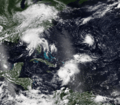2021 Atlantic hurricane season facts for kids
The 2021 Atlantic hurricane season was a time when many big storms, called tropical cyclones, formed in the Atlantic Ocean, Gulf of Mexico, and Caribbean Sea. These storms include hurricanes and tropical storms. The official season usually runs from June 1 to November 30 each year. However, sometimes these powerful storms can form outside of these dates.
Naming the Storms
When a tropical storm gets strong enough, it is given a name. This helps people track it and talk about it easily. The names for storms in the North Atlantic are chosen by the World Meteorological Organization (WMO).
After a hurricane season ends, the WMO looks at the names used. If a storm caused a lot of damage or deaths, its name might be "retired." This means that name will never be used again for another storm. This helps people remember the most impactful storms. Any names not retired are used again six years later. For example, the names from the 2021 season (that weren't retired) will be used again in the 2027 season.
The list of names for 2021 was mostly the same as the one used in the 2015 season. The only changes were Elsa and Julian, which replaced Erika and Joaquin.
Here are the names that were used or ready to be used for storms in 2021:
|
|
|
Images for kids
-
Three tropical cyclones were active at the same time in the North Atlantic on August 16, 2021: Fred (left), which was about to hit Florida; Grace (bottom), south of Hispaniola; and a tropical depression (upper right) near Bermuda, which later became Henri.
-
Hurricane Ida was getting much stronger very quickly. This picture was taken from the International Space Station on August 28, 2021.
See also
 In Spanish: Temporada de huracanes en el Atlántico de 2021 para niños
In Spanish: Temporada de huracanes en el Atlántico de 2021 para niños



